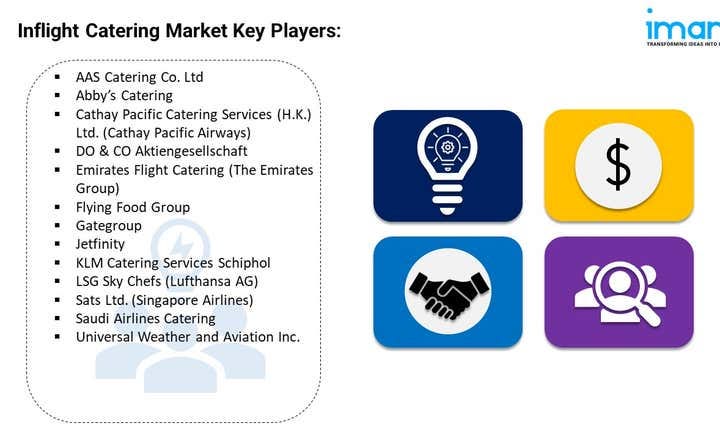
Market Overview:
The inflight catering market is experiencing rapid growth, driven by premiumization & experiential dining, sustainability & responsible sourcing, and digital integration & personalized services. According to IMARC Group’s latest research publication, “Inflight Catering Market Size, Share, Trends and Forecast by Food Type, Flight Service Type, Aircraft Seating Class, and Region, 2025-2033”, The global inflight catering market size was valued at USD 13.8 Billion in 2024. Looking forward, IMARC Group estimates the market to reach USD 18.7 Billion by 2033, exhibiting a CAGR of 3.39% from 2025-2033.
This detailed analysis primarily encompasses industry size, business trends, market share, key growth factors, and regional forecasts. The report offers a comprehensive overview and integrates research findings, market assessments, and data from different sources. It also includes pivotal market dynamics like drivers and challenges, while also highlighting growth opportunities, financial insights, technological improvements, emerging trends, and innovations. Besides this, the report provides regional market evaluation, along with a competitive landscape analysis.
Grab a sample PDF of this report: https://www.imarcgroup.com/inflight-catering-market/requestsample
Our report includes:
Factors Affecting the Growth of the Inflight Catering Industry:
The Inflight Catering Market implements good serving services that make memorable foods to improve the loyalty of the airline's passenger satisfaction and the brand. The most important industry changes mainly include first class and professional premium eateries that offer Petru Food Works from celebrity chefs with personal food experiences. Airlines allocate funds to provide premium foods during the purchase of special alcohol and traditional beverage products to develop air foods. Line services directly direct their energy to privatization while setting up the interactive food meeting that offers virtual lessons on alcohol and videos showing cooking performances. Combined high tiles combined with modern entertainment systems have increased food functions that provide memorable math services. Airlines from the industry work through commercial agreements with local food creators and restaurant operators for authentic regional food available in their flight menu. During the final phase of service distribution, the premium segment reaches its highlight through personal service, including accommodating employees who provide customized menu recommendations to customers. The flight industry dedicated to the award to introduce unforgettable dining experiences at the flight height and provide extraordinary memories to customers.
The inflight catering chose permanent purchasing practices as the main priority due to the increase in the state's environmental awareness measures. Durable exercises generated from small -scale environmental improvement and catering products now provide full advantage for the supply chain for waste deficiency. During some seasonal periods, the purchase strategy chooses neighborhood content to reduce transport emissions and promote the national airline areas operated by catering companies. The management team of companies uses two main approaches through their maintenance of equipment operations with environmentally responsible plastic dispositions and their maintenance of equipment operations with better waste management skills and biodegradable packaging packaging system integration. The market has supported environmental ideas by creating permanent additions to plantic food and permanent seafood options for retail installations. Many organizations pursue recycling programs with fertilizer programs to reduce the version of landfill. The flight industry chooses suppliers by evaluating companies that maintain permanent agricultural practices with moral work standards. Marketing practices that allow consumers to see the certification process through fair trade and organic labels create trust between industry operators and users. The food industry should fulfill a unified industrial revolution to reduce the impact on the planet due to environmental considerations.
Inflight catering has standardization of digital solutions because these digital adjustments simultaneously increase operating results and meet airline requirements. The market develops with digital system integration by increasing control of food orders and storage management and distribution operations. Implementation of customer food for a specific diet helps airlines to provide better service to customers and reduce the loss of food. Real-time data analysis that works by hand with A-interactive forecasting systems makes digital platforms more effective in adapting distribution processes and analyzing their previous operating patterns. Modern airlines passengers want Digital Food Service that integrates recreational options into the food options from airlines. Smart trolleys that collaborate with temperature -controlled storage solutions provided security protection for airlines and stable food quality maintenance. Passengers can provide feedback using mobile applications available through digital platforms and select specific service distribution methods. Airlines use enlarged reality and virtual reality technologies to develop interactive materials that adapt food experiences as part of improving their development. Digital platforms through technology integration provide passengers effective personal experience of their organized food service experience.
Leading Companies Operating in the Global Inflight Catering Industry:
